Botanical illustrations recording natural history are a popular and important art form, with original plates and reprints of historic watercolours used for both scientific and decorative purposes. These works on paper can often be fragile due to their medium and age, requiring specific atmospheric conditions, specialist framing and professional conservation treatments to ensure their longevity.
 Above: botanical illustration prints and watercolours can be professionally restored when they face staining and water damage
Above: botanical illustration prints and watercolours can be professionally restored when they face staining and water damage
This article will cover the history of these beautiful and intriguing artworks, including the value they may reach at auction and the ways they can be safely cared for. We will also look at the restoration of works on paper, featuring wonderful results following foxing disturbances, common accidents and major disasters.
 Above: examples of botanical illustration plates from the late 18th and early 19th centuries
Above: examples of botanical illustration plates from the late 18th and early 19th centuries
Famous botanical illustrators
In auction houses today, botanical illustrations can sell for high sums depending on their visual appeal and connection to famous names. In May 2022 a collection of 36 prints by Pierre-Joseph Redouté sold for £126,000 in London, far surpassing an estimate of £50,000. Average prices for popular collections of illustrations are around £10,000 and remain popular with buyers.
 Above: a selection of illustrations by Pierre-Joseph Redouté
Above: a selection of illustrations by Pierre-Joseph Redouté
The origins of botanical illustration date back to classical antiquity, this was primarily due to the use of herbal remedies in medicine and the requirement for this information to be recorded. The Codex Vindobonensis, a copy of an earlier work by Dioscorides, dates to 512 and was created for the daughter of Roman Emperor Olybrius. Books like these were important to ensure that herbs and plants were not lost in translation between the many dialects and languages of the Roman Empire.
 Above: a botanical illustration from the 16th century by Jacques Le Moyne de Morgues
Above: a botanical illustration from the 16th century by Jacques Le Moyne de Morgues
Botanical illustrations continued to be used throughout history, such as the 6th century Vienna Dioscurides, but it was the introduction of the improved printing press in the 18th century that allowed it to really take hold as a necessary and much-admired part of scientific research. Due to the new quality of print, original watercolours and fine drawings could be accurately reproduced and allowed all known species under botanical nomenclature (that is plants given a scientific Latin name) to be vividly recorded.
 Above: botanical illustrations from Iran, 17th century
Above: botanical illustrations from Iran, 17th century
Illustrators from the 17th and 18th centuries include:
- John Dunstall (1644-1675)
- Alexander Marshal (1620-1682)
- Elizabeth Blackwell (1707-1758)
- Augusta Innes Withers (1792-1877)
- Maria Sibylla Merian (1647 – 1717)
- John Miller (1715-1792)
- Peter Brown (1758-1799)
- Sydenham T. Edwards (1768-1819)
- Sydney Parkinson (1745-1771)
- William Jackson Hooker (1785-1865)
- Pierre-Joseph Redouté (1759-1840)
 Above: an illustration of tulips by Jacob Marrel from the 17th century
Above: an illustration of tulips by Jacob Marrel from the 17th century
As the cultural enlightenment of the 18th century continued, greater interest was shown in botany and gardening for both scientific and philosophical reasons, making botanical books popular in aristocratic and newly emerging middle-class homes across Britain. There was also much expansion of knowledge in this era, as the New World opened up to exploration. The use of pictures made what was primarily scientific literature an accessible encyclopedia of plant life that could be appreciated by wider audiences. The 18th century saw the production of the Flora Graeca illustrations by John Sibthorp and Ferdinand Bauer, along with many other print recordings used in pamphlets and publications.
 Above: illustrated plates from the Flora Graeca as printed in 1806
Above: illustrated plates from the Flora Graeca as printed in 1806
The 19th century had further engagement with natural history and research, with artists continuing to specialise in the accurate interpretation of botany. An influential illustrator from the Victorian era is Marianne North, who between 1871 and 1885 painted over 800 illustrations in oil paint. After selling up her home aged 40, she spent the next 14 years visiting 17 countries on 6 continents to dedicate her life to recording plant life.
Further 19th century artists specialising in the field include:
- Anne Pratt (1806-1893)
- Beatrix Potter (1866-1943)
- Priscilla Susan Bury (1799-1872)
- Walter Hood Fitch (1817-1892)
- Matilda Smith (1854-1926)
 Above: an ashoka tree flower illustration from the early 19th century
Above: an ashoka tree flower illustration from the early 19th century
The 20th century saw important studies such as The Cactaceae by Lord Britton and Joseph Nelson Rose, as well as The Banksias published in 1981. The Banksias was a remarkable work comprised of 30 books and 100 portfolios for just the first volume, all by a single illustrator called Celia Rosser. Rosser has also released her work as prints, acknowledging the use of botanical illustration as artwork for the home.
Renowned 20th century illustrators also include:
- Margaret Mee (1909-1988)
- Albert Robert Valentien (1862-1925)
- Lilian Snelling (1879-1972)
- Arthur Harry Church (1865-1937)
- Rory McEwen (1932-1982)
- Stella Ross-Craig (1906-2006)
- Pandora Sellars (1936-2017)
- Raymond Booth (1929-2015)
 Above: a 19th century watercolour illustration of ocean life by James M. Sommerville
Above: a 19th century watercolour illustration of ocean life by James M. Sommerville
Caring for botanical prints and watercolours
Paper can become severely damaged by historic framing techniques that have used acidic mounts, glues and backing boards. These discolour and deteriorate the surrounding area, so the first aspect of caring for your print or watercolour should always be to ensure conservation-approved materials have been used and that no hidden dangers are lurking.
 Above: one of our framing specialists providing a conservation-appropriate environment for a botanical work on paper
Above: one of our framing specialists providing a conservation-appropriate environment for a botanical work on paper
Wooden backings or non-acid free boards should always be replaced, whether or not the deterioration or staining has started to show through, as it will be an issue in the future. Furthermore, no masking tape or glue should ever be in direct contact with the artwork. The painting or print should be well-sealed in the frame to avoid insects and debris, make sure to check the gum tape on the back is secure.
Locations for the display of illustrations should always be away from direct sunlight. Works on paper are extremely vulnerable to fading, this is a damage that cannot be restored and so should be a main point of concern when caring for expensive or sentimentally important artworks. The watercolour pigments most vulnerable to fading are brown, red and indigo, often leaving an uneven visual effect if they are left in direct sunlight.
 Above: our framing specialist preparing UV protective glazing for a print
Above: our framing specialist preparing UV protective glazing for a print
UV protective glass is available, our framing specialists can arrange to have this put in place for extra protection. Windows can also be sealed with UV protective shielding. However, a shaded location is always preferable whether or not UV protection is in place, to ensure that the atmosphere surrounding the artwork is not disturbed by exterior heat.
The correct environment for a print or watercolour is key to their safety and ongoing health. Paper does not like to be too moist or too dry, so an even level of humidity of around 50% is important to ensure that the air does not compel mould and foxing growth, or create a dry and brittle surface. For highly valuable prints or original artworks on paper, it may be worthwhile keeping them in a fully controlled and monitored environment. Temperatures should also be kept at around 20-22 degrees C to prevent any fluctuations that could cause expansion and contraction of the paper in its mount.
 Above: a print in direct sunlight – this should be avoided as much as possible to prevent fading
Above: a print in direct sunlight – this should be avoided as much as possible to prevent fading
The continued survival of antique prints and watercolours can be heavily affected by the materials used to create them. The quality of the paper may determine whether or not it will be vulnerable to severe levels of foxing or brittle deterioration over time, as well as the possibility of a darkening or yellowing surface.
 Above: botanical artworks in old mounts and frames that may be harbouring acidic elements
Above: botanical artworks in old mounts and frames that may be harbouring acidic elements
Surprisingly, paper from before the 19th century may be more resilient, this is because historic paper has a high cellulose content due to it being partly produced from linen. Victorian or modern paper is primarily made from wood pulp, including a lot of acidic light-sensitive substances as well as bleaching chemicals that deteriorate over time, causing the dark, brittle decay you may come across today. There are environmental controls that can be put in place to slow down any age or material related deterioration, but if you have concerns our team is happy to have your treasured piece examined by our ICON accredited paper conservator.
 Above: some paper artworks naturally begin to degrade and discolour as they age
Above: some paper artworks naturally begin to degrade and discolour as they age
Botanical illustration restoration
Our ICON accredited paper conservator is able to use specialist treatments to eliminate visual disturbances from foxing, mould growth, acidic staining and framing materials. Using a gentle technique, prints and watercolours can be floated in a solution that brings away the yellowing or darkening tones but does not disturb the original paint pigments or ink. This process will also help to destroy mould spores and provide protection against future outbreaks of foxing.
Bent, crinkled or warped paper can also have sensitive care provided to flatten it back into shape, this will take into account the stability of any paint that may have been lost or caused to flake by the damage. Our conservator will consolidate the loose pigments and if needed can gently reapply missing areas with a safe and sympathetic approach. All treatments are performed with a focus on the historic and artistic integrity of the artwork.
 Above: watercolours and prints can have discolouration and staining safely removed
Above: watercolours and prints can have discolouration and staining safely removed
Works on paper with small or major tears can have successful restorations. Torn fibres can be re-adhered and conservation-friendly Japanese tissue paper can be used to strengthen the overall artwork.
 Above: even the most dramatically torn artworks can be restored, this is a recent example from our studio
Above: even the most dramatically torn artworks can be restored, this is a recent example from our studio
Our team often cares for paper that has been in a household disaster, such as a flood, leak or fire. Following events such as these, broken or brittle paper can be stabilised in our studio, and any wet or damp paper can be dried safely in a clean environment away from industrial drying units. Water staining can be removed, as well as any disturbance caused by mould spores, fire debris, and smoke.
Once the restoration has taken place, new frames can be provided if required. This includes options for UV protective museum-view glass, acid-free mounts and backing boards, and a selection of frames that suit the artwork or your own interior design choice.
 Above: mould damage can be removed and restored following water damage
Above: mould damage can be removed and restored following water damage
How can we help?
If you have a botanical illustration or a similar work on paper that may be in need of restoration, please speak to our helpful team for further advice.
Please get in touch by emailing [email protected] or call 0207 112 7576 for swift advice and a conversation about our services.

 Above: botanical illustration prints and watercolours can be professionally restored when they face staining and water damage
Above: botanical illustration prints and watercolours can be professionally restored when they face staining and water damage Above: examples of botanical illustration plates from the late 18th and early 19th centuries
Above: examples of botanical illustration plates from the late 18th and early 19th centuries Above: a selection of illustrations by Pierre-Joseph Redouté
Above: a selection of illustrations by Pierre-Joseph Redouté Above: a botanical illustration from the 16th century by Jacques Le Moyne de Morgues
Above: a botanical illustration from the 16th century by Jacques Le Moyne de Morgues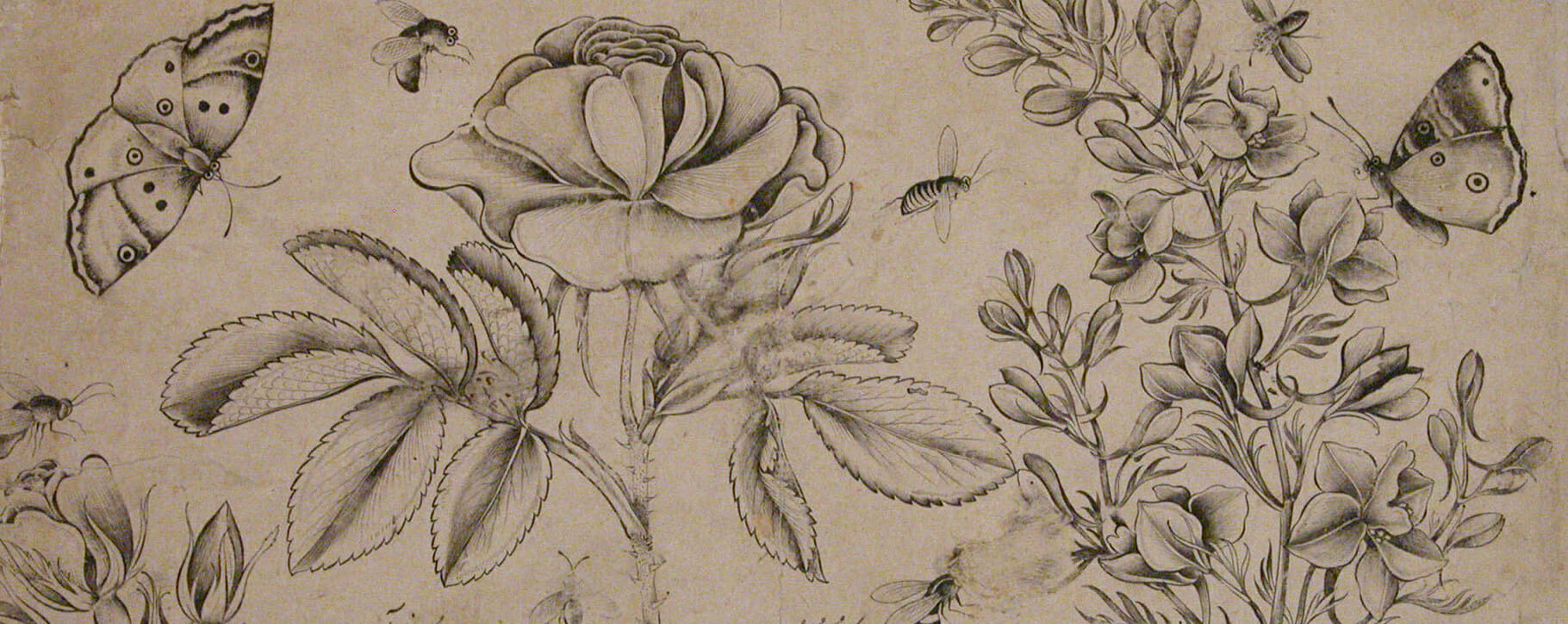 Above: botanical illustrations from Iran, 17th century
Above: botanical illustrations from Iran, 17th century  Above: an illustration of tulips by Jacob Marrel from the 17th century
Above: an illustration of tulips by Jacob Marrel from the 17th century Above: illustrated plates from the Flora Graeca as printed in 1806
Above: illustrated plates from the Flora Graeca as printed in 1806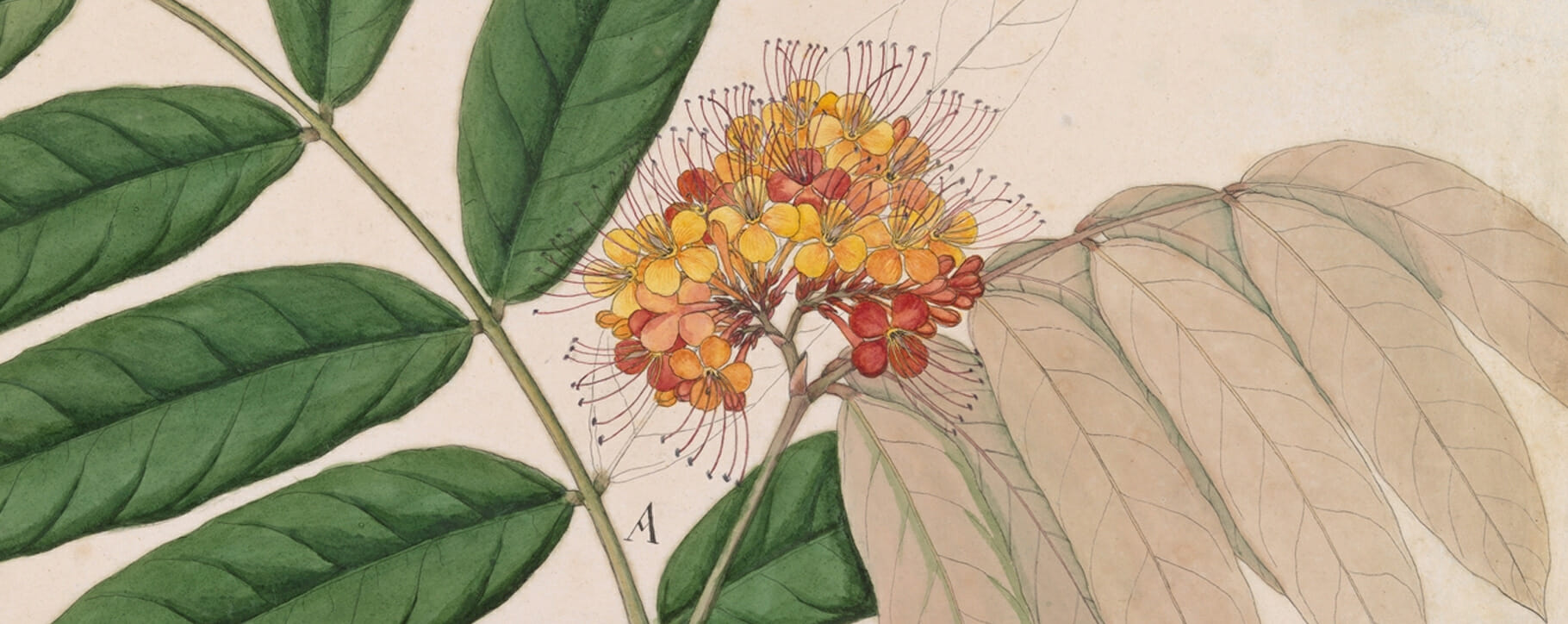 Above: an ashoka tree flower illustration from the early 19th century
Above: an ashoka tree flower illustration from the early 19th century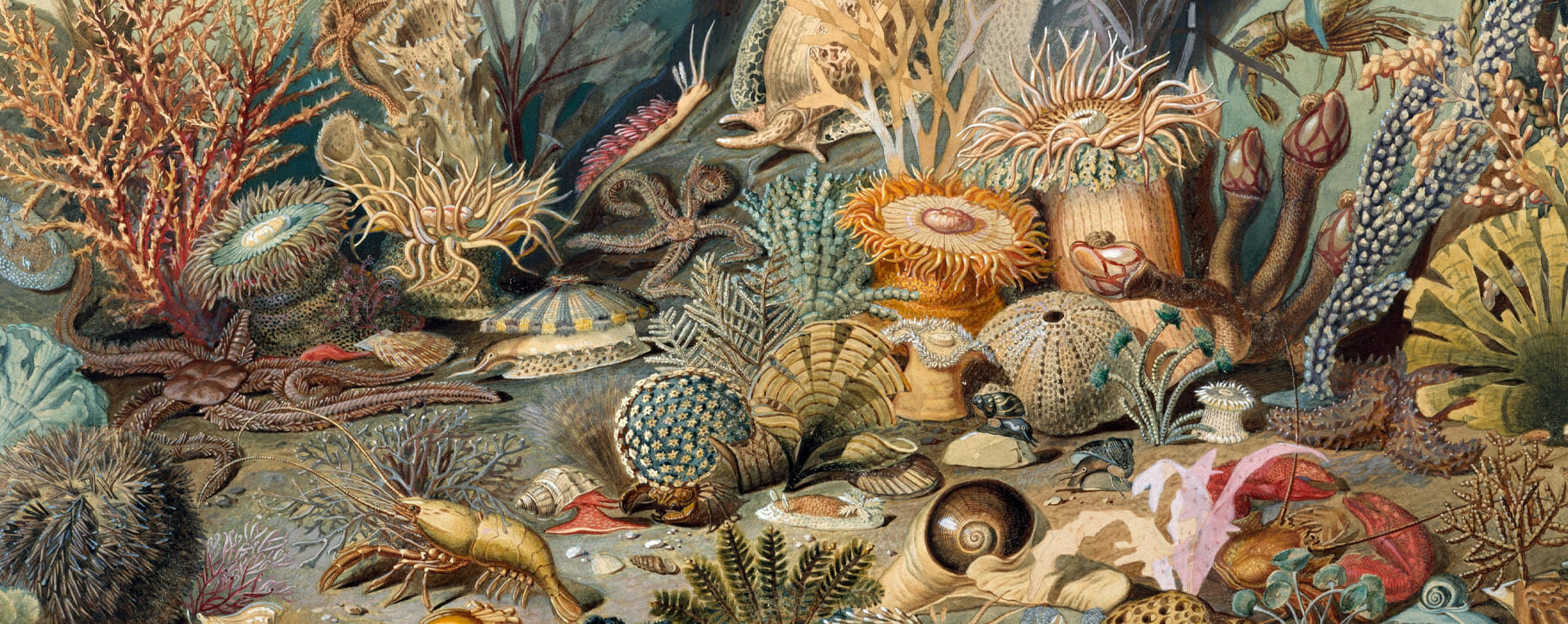 Above: a 19th century watercolour illustration of ocean life by James M. Sommerville
Above: a 19th century watercolour illustration of ocean life by James M. Sommerville Above: one of our framing specialists providing a conservation-appropriate environment for a botanical work on paper
Above: one of our framing specialists providing a conservation-appropriate environment for a botanical work on paper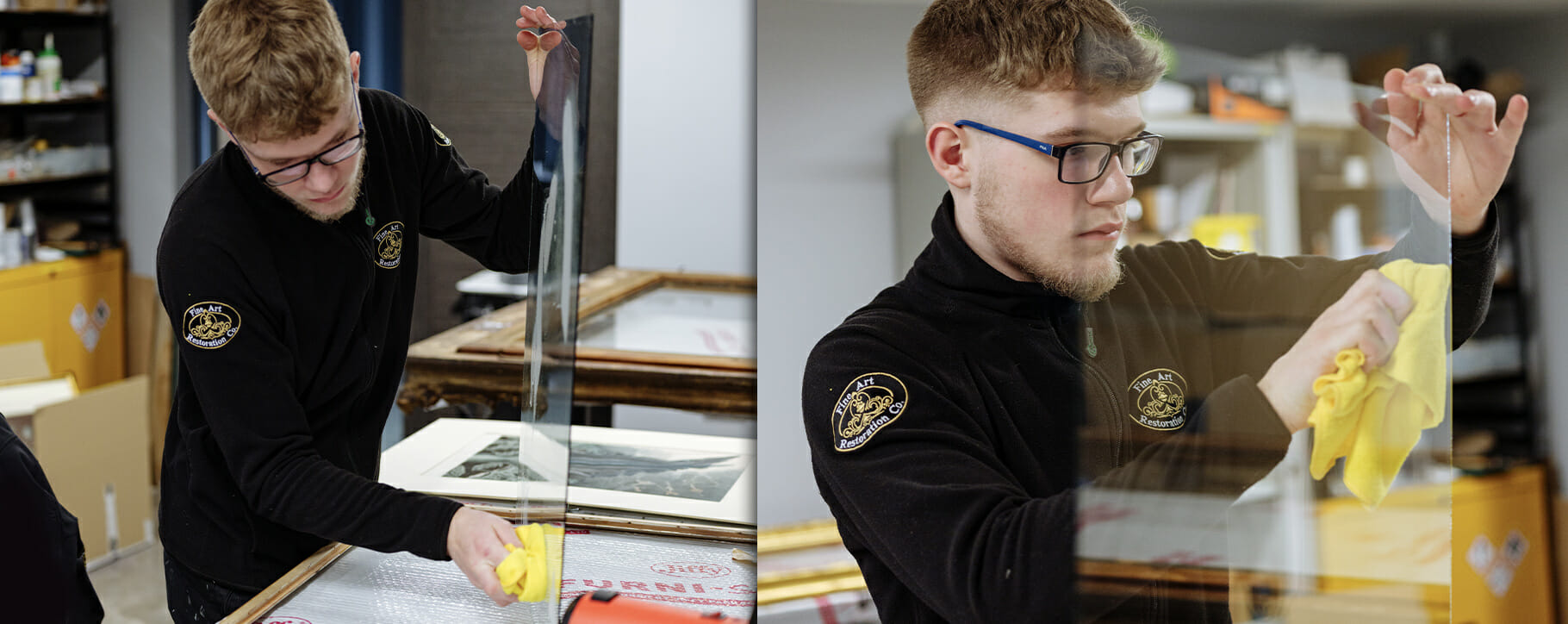 Above: our framing specialist preparing UV protective glazing for a print
Above: our framing specialist preparing UV protective glazing for a print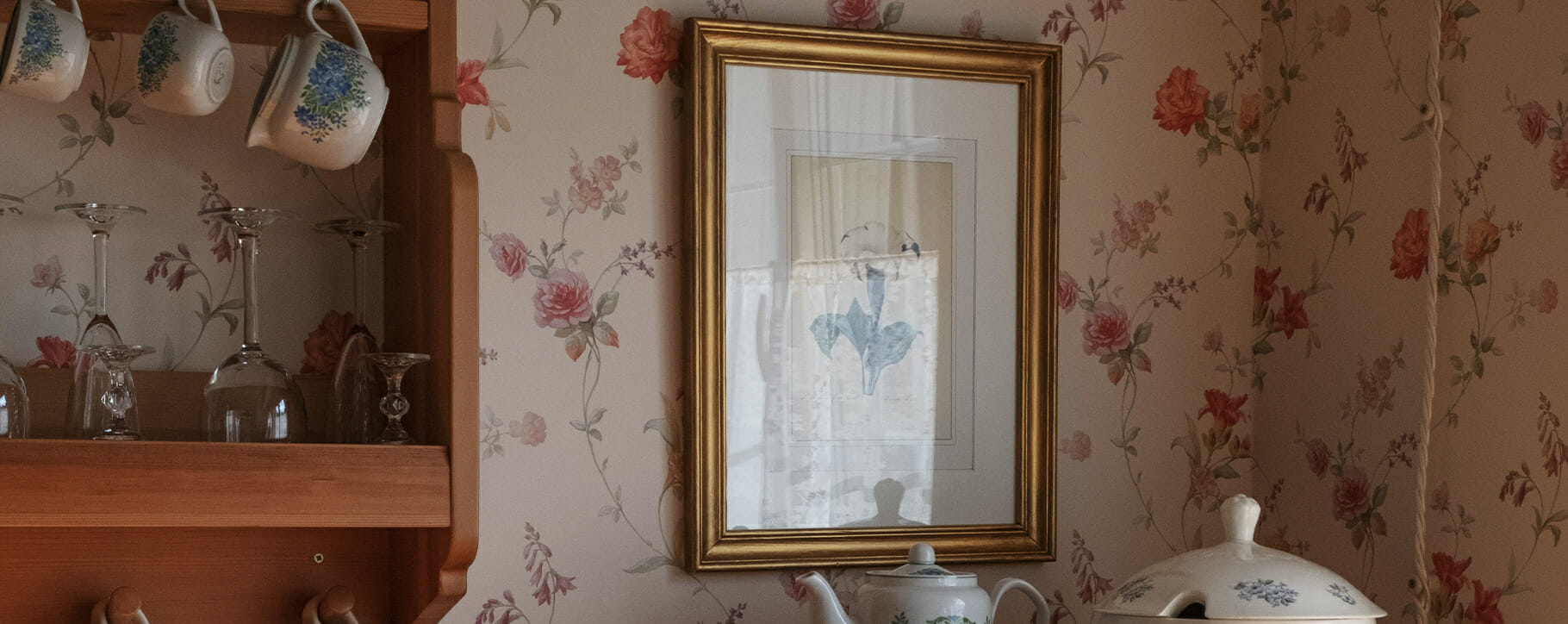 Above: a print in direct sunlight – this should be avoided as much as possible to prevent fading
Above: a print in direct sunlight – this should be avoided as much as possible to prevent fading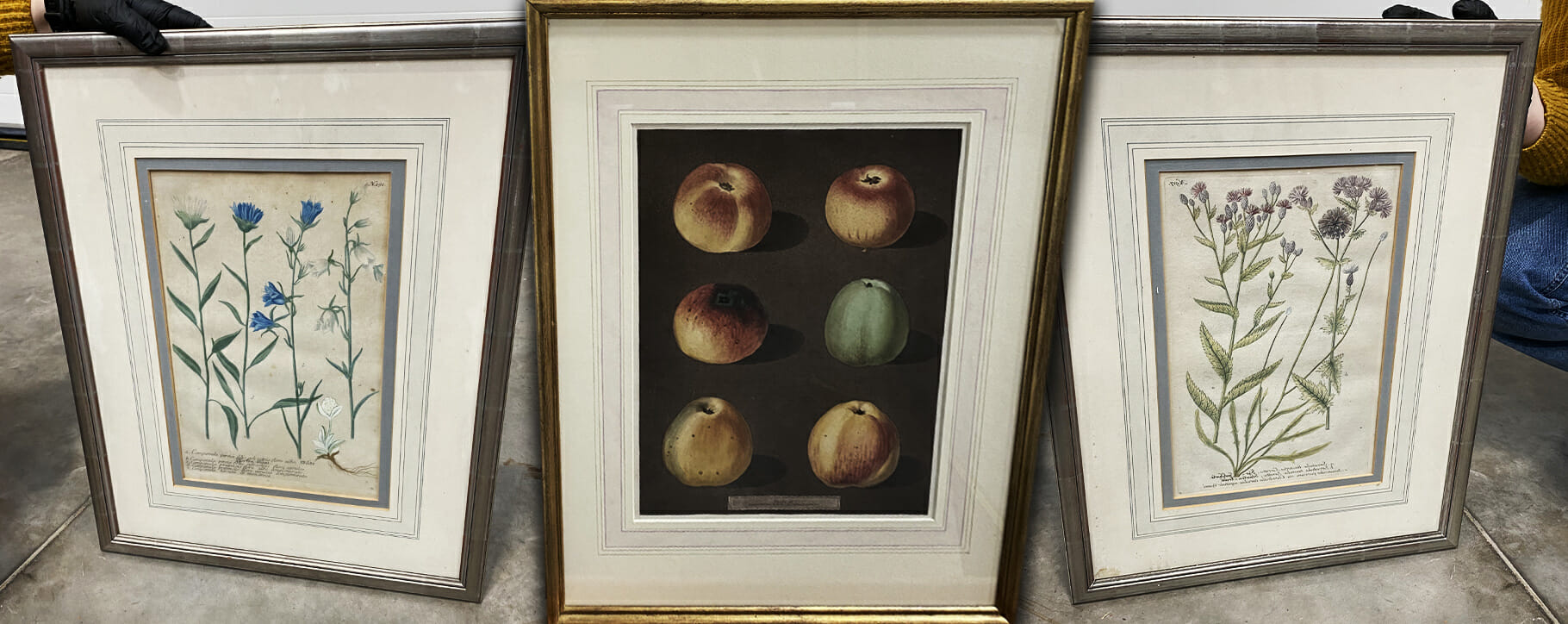 Above: botanical artworks in old mounts and frames that may be harbouring acidic elements
Above: botanical artworks in old mounts and frames that may be harbouring acidic elements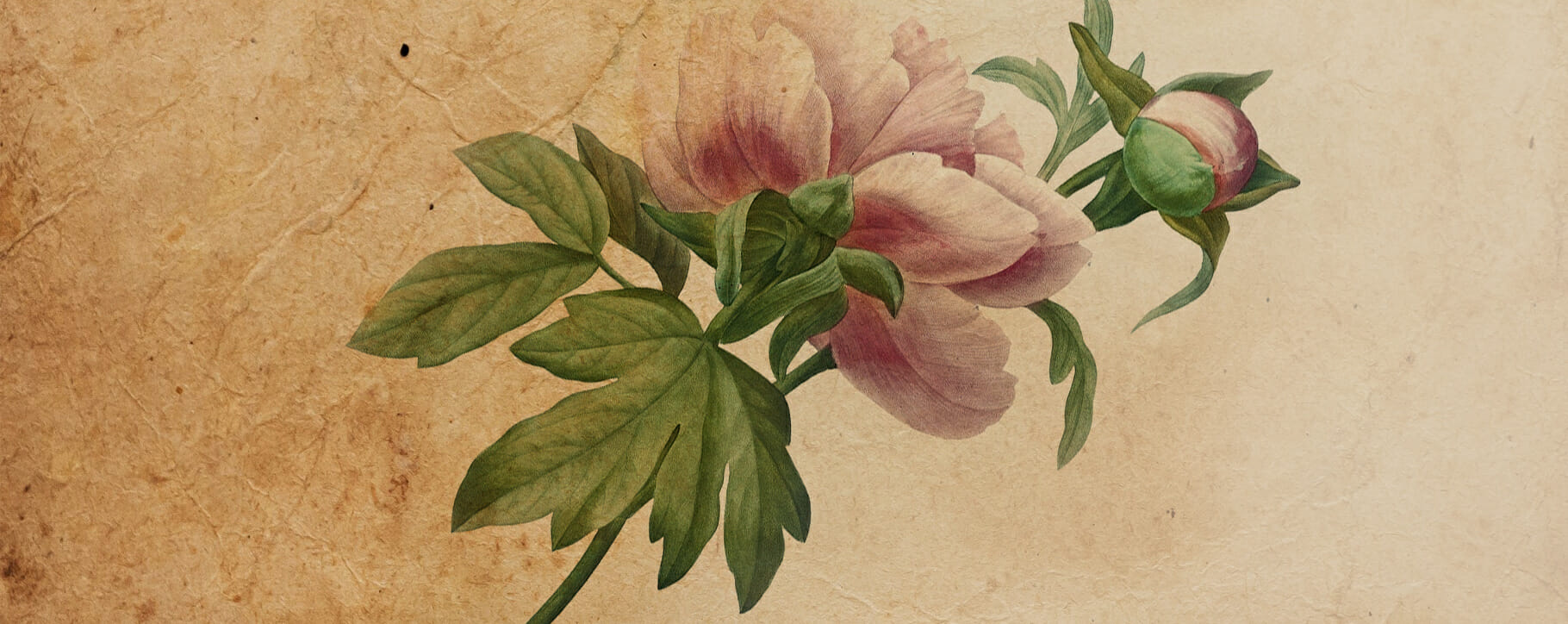 Above: some paper artworks naturally begin to degrade and discolour as they age
Above: some paper artworks naturally begin to degrade and discolour as they age Above: watercolours and prints can have discolouration and staining safely removed
Above: watercolours and prints can have discolouration and staining safely removed Above: even the most dramatically torn artworks can be restored, this is a recent example from our studio
Above: even the most dramatically torn artworks can be restored, this is a recent example from our studio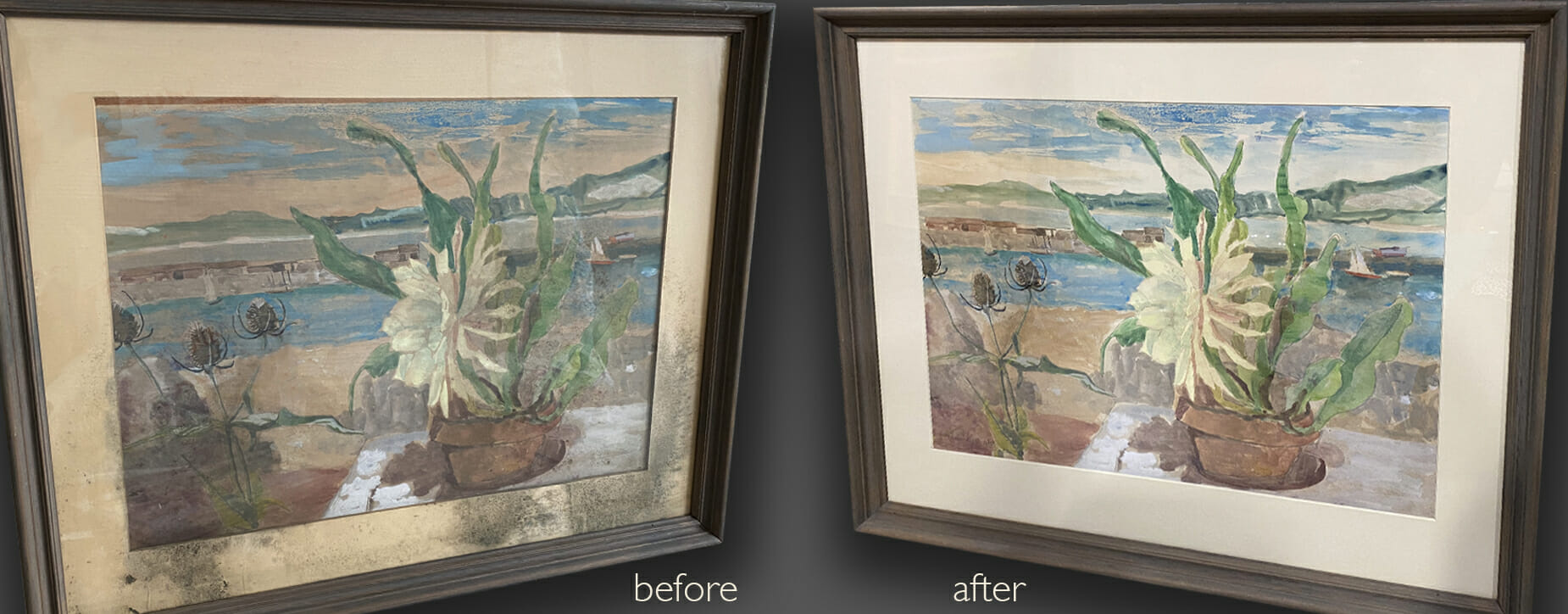 Above: mould damage can be removed and restored following water damage
Above: mould damage can be removed and restored following water damage




